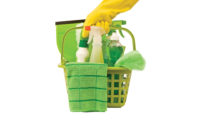When working with facilities transferring from a conventional to a green-cleaning strategy, there are a number of key steps that must be taken: get the C-suite on board; discuss with building users why the facility is transferring to green cleaning (to help protect their health); and get the custodial crew behind the transfer, etc. One first step often overlooked involves the janitorial closet. For an effective green-cleaning program to work, it must start at the “heart” of cleaning, which in most facilities is the janitorial closet.
All cleaning solutions, green or traditional, must be respected because they can be potentially harmful if used improperly. And the janitorial closet contains the tools of the trade for cleaning workers. Just as the carpenter values his tool kit or the doctor her stethoscope, the chemicals, tools and equipment used for cleaning should also be valued and appreciated.
So, where do we begin in a “green janitorial closet makeover?” We first must have a “meeting” with the closet. Among the things we are going to look at and consider in this meeting:
- How it is organized or, to be more direct, is it organized?
- How clean is it?
- Is the floor dry?
- Is it well lit?
- Is hot and cold water available?
- Are there drains plumbed for appropriate disposal of liquid waste?
- Are items easy to reach and readily accessible?
- Are products on shelves or on the floor?
- Is it properly ventilated with outside exhaust (janitorial closets should have their own ventilation not shared with the building’s ventilation system)?
You should know that the appearance and organization of the janitorial closet can set the tone for cleaning workers and the overall maintenance of the entire facility. A disorganized closet looks unprofessional and makes cleaning workers feel unprofessional.
But the cleaner and better organized it is, the more respect the cleaning workers have for their work, which typically translates into a higher quality of work.
Empty and remove
There are interior designers that specialize in redecorating residences using items the client already has. Usually their first step is to take everything out of a room, strip it bare and then start over.
Well, this is how we begin a green janitorial closet makeover. We remove all cleaning solutions, tools, products and equipment. Our next steps are as follows:
- Remove and properly dispose of any cleaning solutions that have not been used in the past year. Most cleaning chemicals have a shelf life and while it can vary, after one year the chemical ingredients may start to decomposeand lose its effectiveness.
- Determine what to do with the old cleaning products. In some cases, a distributor or manufacturer will offer a “take-back” program if the chemicals are exchanged for green equivalents. If not, and if the quantity of cleaning solutions is large, the most cost-effective thing to do may be to finishthe products before switching to green cleaning solutions.
With everything removed, we want to thoroughly clean the closet and examine the interior walls and ceiling. Check that vents are working properly and clean as necessary; check that drains are clear. Make sure lighting is installed — that it is adequate and, preferably, that it turns on as soon as the door is opened. Now is a perfect time to paint the closet — a light-colored paint is advised because it lifts the user’s spirits, is easier to keep clean and makes finding products easier.
Additionally, the shelving should be inspected. Shelving for a green janitorial closet should be affixed to the wall. Having sturdy, grill- or rack-type shelving is preferable because it helps improve air circulation and ventilation, plus it allows spills to fall to the floor, making cleanup easier.
Organize, prioritize, code
Organization of the closet as it is being restocked is very important, and different aspects require attention. First, we want to store no more chemicals in the closet than can be used in about a week’s time. Gallon and larger containers should be stored separately from the daily-use janitorial closet. This improves safety and helps prevent fumes from being released.
Next, items should be organized based on how they are used. For instance, all restroom products would be on one shelf, separated from floor-care products. Related to this, it is often recommended that some sort of color-coding system be developed. For many cleaning workers in the U.S., English is a second language. For safety reasons, to speed up the cleaning process and to ensure the right chemical is selected for each cleaning task, some facilities will place a red label on all products used for cleaning restrooms, etc.
Additionally, it is often helpful to prioritize certain cleaning solutions. We can have one shelf where only products used on a frequent or daily basis are stored. This helps eliminate errors and speeds up the cleaning process.
Off the floor
Finally, it is important to keep all cleaning-related products off the floor when possible. This should also apply to equipment such as vacuum cleaners.
Now, with our green janitorial closet makeover complete, what is most important is to keep it that way. What is often recommended is to include the closet in regular facility inspections. In fact, it should be the first thing inspected because, as we mentioned earlier, the appearance of the closet often sets the stage for how well the facility is being maintained.
|
LEED-EB (existing buildings) and green janitorial closets Until recently, facilities seeking LEED-EB certification could earn one credit for having and maintaining a green janitorial closet. In order to get this credit, the closet had to be: • Structurally sealed (or isolated from the rest of the facility) • Include an independent ventilation system • Be equipped with hot and cold water and plumbed for proper disposal of liquid waste • Be organized in such a way that it minimizes the cleaning staff’s exposure to chemicals • Have adequate lighting • Have readily accessible Safety Data Sheets, formerly known as MSDS • Be properly maintained, cleaned and organized |



